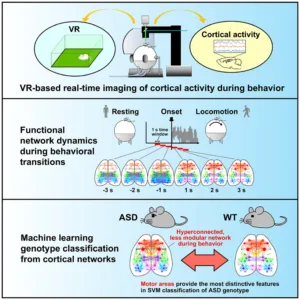Autism is a neurodevelopmental disorder characterized by poor social communication, intense preoccupation with certain things, and repetitive behaviors. There is a growing number of people with autism and current diagnosis is based on behavioral characteristics, making it difficult to quantify. Researchers have been studying functional brain abnormalities unique to individuals with autism. Resting-state functional magnetic resonance imaging (fMRI) studies suggest that the density of functional brain networks increases in young individuals with autism and decreases in adults. However, these changes vary widely from person to person. Genetics play a significant role in autism and genomic abnormalities are thought to be involved in the neuropathology.

In a recent study, a virtual reality (VR) imaging system was developed to measure the brain activity of autism model mice in real-time during active behavior. By investigating brain functional network dynamics, the researchers aimed to clarify autism-specific phenomena in the brain during behavior. The researchers used transgenic mice that express calcium sensor protein in their neurons and established a method for analyzing cortical functional network dynamics. The results revealed that the network structure changes with the onset of locomotion and that modularity increases. The researchers also found that machine learning can identify autism model mice based on their functional cortical network patterns associated with behavioral changes.
The functional brain network in mouse models of autism is characterized by the functional connectivity of the motor cortex, which is crucial for determining autism. Further research on the functional brain network dynamics of autism during active behavior is expected to lead to the discovery of new biomarkers for the diagnosis of autism. The researchers would like to construct a social environment for mice in a virtual space and investigate how the functional network dynamics change when autism model mice perform social behaviors.
Reference
Nakai, N., Sato, M., Yamashita, O., Sekine, Y., Fu, X., Nakai, J., Zalesky, A., & Takumi, T. (2023). Virtual reality-based real-time imaging reveals abnormal cortical dynamics during behavioral transitions in a mouse model of autism. Cell Reports, 0(0). https://doi.org/10.1016/j.celrep.2023.112258

